SMUD 2024 Summer Steam Project (June 19-27)
Pioneering Sustainability and Climate Change Educationivoting for Access and Engagement
Project Overview:
This project is a testament to the power of community and education, bringing together the expertise of SMUD, the cultural significance of the Sojourner Truth African Heritage Museum, and the innovative spirit of Legacy BU. Our goal is to create an engaging and interactive virtual environment that highlights the importance of sustainability and climate action.
“Sustainable Futures” is an engaging, project-based online course that introduces high school students to the exciting world of virtual reality (VR) while exploring critical topics like climate change and sustainability. Using state-of-the-art VR tools such as Spatial.io, Miro, and Sketchfab, students will learn to design, create, and curate virtual exhibits that educate and inspire action on these vital issues. Students will have the opportunity to focus on key initiatives by SMUD, including electric vehicles, solar and storage, going green, rebates and savings, business energy advisories, and community support.
Key Features:
- Interactive Tours: Take a virtual tour of SMUD facilities and renewable energy sites, gaining firsthand insight into how energy is generated, managed, and distributed sustainably.
- Immersive VR Experiences: Dive into virtual reality experiences that simulate the effects of climate change and showcase the positive impact of SMUD’s sustainability initiatives.
- Educational Modules: Engage with interactive modules that cover a wide range of topics, from renewable energy and energy efficiency to community programs and environmental stewardship.
- Gamified Learning: Earn points, badges, and rewards by completing quizzes, challenges, and virtual scavenger hunts designed to make learning about sustainability fun and rewarding.
- Storytelling and Multimedia: Experience compelling stories and narratives through videos, animations, and audio content that illustrate the real-world implications of climate change and the efforts to combat it.
- Virtual Workshops and Webinars: Participate in live virtual events, workshops, and webinars hosted by SMUD experts, offering deep dives into specific sustainability topics and hands-on activities.
- Community Engagement: Join a thriving online community where you can share your experiences, collaborate on sustainability projects, and engage in meaningful discussions about climate action.
Special Collaboration: Empowering Youth:
As the founder of Legacy BU, I took on the role of curriculum developer, instructor, and VR space developer for this project. In partnership with the Sojourner Truth African Heritage Museum, I taught 10 students aged 10-17 how to create and curate their own VR spaces. The students learned to:
- Design Custom Avatars: Using Ready Player Me, each student designed a unique avatar to represent themselves in the virtual space.
- Develop Storyboards: Utilizing Miro, the students created detailed storyboards to plan and present their own sustainability-focused VR spaces.
- Curate VR Spaces: The students brought their storyboards to life by developing and curating immersive VR experiences that reflect their understanding and vision of sustainability.
Why This Matters:
Climate change is one of the most pressing issues of our time, and educating our community about sustainable practices is crucial for creating a resilient and sustainable future. This virtual space not only provides valuable knowledge but also inspires action and empowers individuals to make a difference.
How It Is Relevant to Students’ Lives: “Sustainable Futures” connects students with real-world issues that affect their communities and the global environment. By engaging in hands-on projects and collaborative learning, students will develop critical thinking, problem-solving, and technical skills that are valuable in many fields. Whether they are interested in science, technology, art, or social justice, this course offers a unique opportunity to explore their passions while contributing to a sustainable future. Through this immersive learning experience, students will see firsthand how they can make a positive impact on the world around them.
Course Learning Outcomes
By the end of this course, students will be able to:
- Understand Virtual Reality (VR) Technology:
○ Navigate and utilize Spatial.io to create immersive virtual environments.
○ Recognize the applications and impact of VR in various fields. - Design and Curate Virtual Exhibits:
○ Apply principles of VR design, including space, interactivity, and user experience.
○ Develop engaging and educational virtual exhibits focused on climate change and sustainability.
- Create Storyboards for VR Projects:
○ Use Miro to plan and visualize their virtual exhibit projects.
○ Organize and structure content effectively for educational purposes. - Source and Integrate Digital Assets:
○ Utilize Sketchfab and other free platforms to find and incorporate digital assets into their projects.
○ Integrate multimedia elements to enhance the user experience in their VRexhibits. - Generate and Use QR Codes:
○ Create QR codes that link to their Spatial.io projects.
○ Understand the applications of QR codes in accessing virtual content. - Explore Climate Change and Sustainability Topics:
○ Gain knowledge about SMUD’s initiatives, including electric vehicles, solar and storage, going green, rebates and savings, business energy advisories, and community support.
○ Develop an understanding of how these initiatives contribute to sustainability and environmental stewardship. - Develop Critical Thinking and Problem-Solving Skills:
○ Engage in project-based learning to address real-world issues.
○ Collaborate with peers to brainstorm, design, and refine their virtual exhibits. - Enhance Presentation and Communication Skills:
○ Present their final VR projects to their peers, articulating their design choices and the importance of their chosen topics.
○ Participate in Q&A sessions to discuss challenges and solutions encountered during their projects. - Gain Insight into Professional Roles:
○ Understand the roles and responsibilities of information professionals, museum curators, and archivists.
○ Explore potential career paths related to VR technology, sustainability, and environmental advocacy.
All information and content on this portfolio and case study are my intellectual property and may not be used, reproduced, or distributed without my explicit written permission.
Release Date: June 19, 2024
Live Discussion and Insights
- Interactive In-Person Session: After the students completed their VR projects, we hosted a live in-person discussion involving the students, their parents, and our team. This session was a platform for sharing experiences, insights, and knowledge gained during the project.
- Positive Learning Experience: The feedback from both students and parents was overwhelmingly positive. They found the experience to be highly educational and enjoyable. The innovative use of VR technology captured their interest and provided a fresh, engaging way to learn about sustainability and climate change.
- Excitement for Future Learning: The students expressed enthusiasm for continuing their learning journey, particularly in areas related to VR and sustainability. Many are now considering careers that incorporate VR technology, inspired by the hands-on experience they gained.
- Innovative Knowledge Sharing: Parents appreciated the innovative approach to education. They recognized the potential of VR as a powerful tool for teaching complex concepts in an accessible and engaging manner.
Feedback Highlights
- Learning Outcomes: Students reported a significant increase in their understanding of sustainability and climate change. The practical application of creating and curating their own VR spaces made the learning process more tangible and impactful.
- Engagement and Enjoyment: The immersive nature of the VR experience kept students highly engaged. They enjoyed the creative aspects of designing avatars and developing storyboards, which made the educational content more relatable and fun.
- Career Inspiration: Exposure to VR technology opened new career possibilities for the students. They are now more aware of how VR can be used in various fields, including education, environmental science, and technology.
- Community and Collaboration: The project fostered a sense of community among the participants. Working together on their VR spaces helped them develop teamwork skills and learn the value of collaboration.
Tools and Technologies
- Storyboarding and Planning
- Tool: Miro
- Usage: Miro, an online collaborative whiteboarding platform, was used for developing storyboards. Students utilized Miro to plan and visualize their VR spaces, organizing their ideas and structuring the content they wanted to present.
- Tool: Miro
- 3D Modeling and Assets
- Tool: Sketchfab
- Usage: Sketchfab was employed for creating and integrating 3D models and assets into the virtual environment. This platform allowed us to access a vast library of 3D models and also upload custom models to enrich the virtual experience.
- Tool: Sketchfab
- Multimedia Content Creation
- Tool: Adobe Express
- Usage: Adobe Express was used for creating multimedia content such as images, graphics, and videos. These elements were integrated into the virtual space to provide dynamic and engaging visual and interactive storytelling.
- Tool: Adobe Express
- Virtual Reality (VR) Platform
- Tool: Spatial
- Usage: Spatial was the primary platform used for developing and hosting the virtual reality environment. It enabled us to create an interactive and immersive VR space where users could explore and engage with the content related to SMUD initiatives.
- Tool: Spatial
- Avatar Creation
- Tool: Ready Player Me
- Usage: Ready Player Me was used for designing custom avatars. Students created their unique avatars, which represented them in the virtual space. This tool made avatar creation accessible and fun, enhancing user engagement.
- Tool: Ready Player Me
Immerse yourself in the innovative world of SMUD initiatives and experience sustainability and climate change education like never before. Explore our virtual space today or contact us to discuss how we can bring similar cutting-edge educational experiences to your organization.
Presentation Materials:


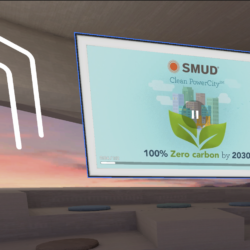
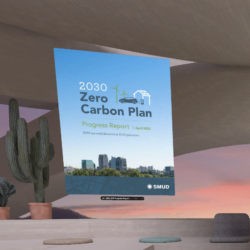
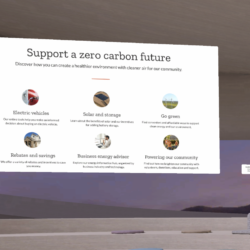
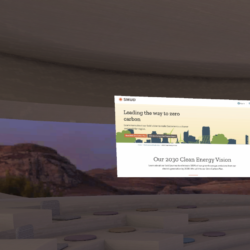
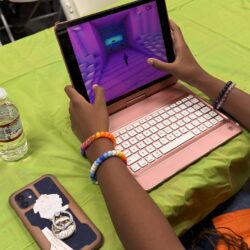
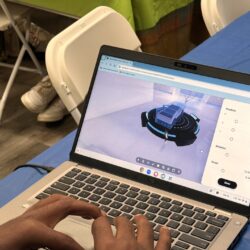

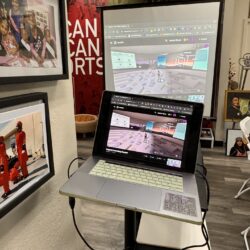
Leave a Reply